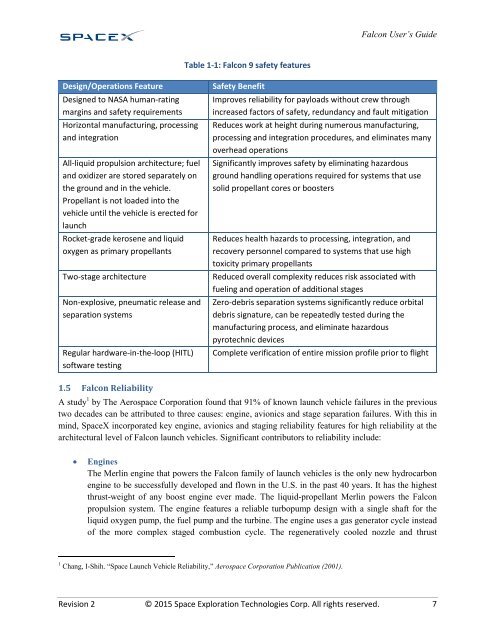PAYLOAD USER’S GUIDE
1S2nU9J
1S2nU9J
You also want an ePaper? Increase the reach of your titles
YUMPU automatically turns print PDFs into web optimized ePapers that Google loves.
Falcon User’s Guide<br />
Table 1-1: Falcon 9 safety features<br />
Design/Operations Feature<br />
Designed to NASA human-rating<br />
margins and safety requirements<br />
Horizontal manufacturing, processing<br />
and integration<br />
All-liquid propulsion architecture; fuel<br />
and oxidizer are stored separately on<br />
the ground and in the vehicle.<br />
Propellant is not loaded into the<br />
vehicle until the vehicle is erected for<br />
launch<br />
Rocket-grade kerosene and liquid<br />
oxygen as primary propellants<br />
Two-stage architecture<br />
Non-explosive, pneumatic release and<br />
separation systems<br />
Regular hardware-in-the-loop (HITL)<br />
software testing<br />
Safety Benefit<br />
Improves reliability for payloads without crew through<br />
increased factors of safety, redundancy and fault mitigation<br />
Reduces work at height during numerous manufacturing,<br />
processing and integration procedures, and eliminates many<br />
overhead operations<br />
Significantly improves safety by eliminating hazardous<br />
ground handling operations required for systems that use<br />
solid propellant cores or boosters<br />
Reduces health hazards to processing, integration, and<br />
recovery personnel compared to systems that use high<br />
toxicity primary propellants<br />
Reduced overall complexity reduces risk associated with<br />
fueling and operation of additional stages<br />
Zero-debris separation systems significantly reduce orbital<br />
debris signature, can be repeatedly tested during the<br />
manufacturing process, and eliminate hazardous<br />
pyrotechnic devices<br />
Complete verification of entire mission profile prior to flight<br />
1.5 Falcon Reliability<br />
A study 1 by The Aerospace Corporation found that 91% of known launch vehicle failures in the previous<br />
two decades can be attributed to three causes: engine, avionics and stage separation failures. With this in<br />
mind, SpaceX incorporated key engine, avionics and staging reliability features for high reliability at the<br />
architectural level of Falcon launch vehicles. Significant contributors to reliability include:<br />
<br />
Engines<br />
The Merlin engine that powers the Falcon family of launch vehicles is the only new hydrocarbon<br />
engine to be successfully developed and flown in the U.S. in the past 40 years. It has the highest<br />
thrust-weight of any boost engine ever made. The liquid-propellant Merlin powers the Falcon<br />
propulsion system. The engine features a reliable turbopump design with a single shaft for the<br />
liquid oxygen pump, the fuel pump and the turbine. The engine uses a gas generator cycle instead<br />
of the more complex staged combustion cycle. The regeneratively cooled nozzle and thrust<br />
1 Chang, I-Shih. “Space Launch Vehicle Reliability,” Aerospace Corporation Publication (2001).<br />
Revision 2 © 2015 Space Exploration Technologies Corp. All rights reserved. 7


